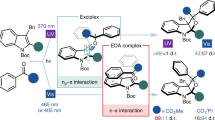Abstract
IT is already known from various investigations that the different isomeric forms of organic molecules give strikingly different Raman spectra. A noteworthy case is that of the cis- and trans- forms of dichlorethylene, which have been studied by Bonino and Brüll (Zeit. für Physik, 58, p. 194; 1929). These investigators have found that the most striking differences appear in the characteristic molecular frequencies lying in the remote infra-red and made so readily accessible to observation by the Raman method.
This is a preview of subscription content, access via your institution
Access options
Subscribe to this journal
Receive 51 print issues and online access
$199.00 per year
only $3.90 per issue
Buy this article
- Purchase on Springer Link
- Instant access to full article PDF
Prices may be subject to local taxes which are calculated during checkout
Similar content being viewed by others
Author information
Authors and Affiliations
Rights and permissions
About this article
Cite this article
BHAGAVANTAM, S., VENKATESWARAN, S. Raman Effect with Optically Active Substances. Nature 125, 237–238 (1930). https://doi.org/10.1038/125237b0
Issue Date:
DOI: https://doi.org/10.1038/125237b0
This article is cited by
-
Raman spectra of terpenes
Proceedings of the Indian Academy of Sciences - Section A (1938)
Comments
By submitting a comment you agree to abide by our Terms and Community Guidelines. If you find something abusive or that does not comply with our terms or guidelines please flag it as inappropriate.



